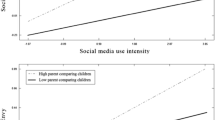Abstract
We use data from 1,755 college students to explore regional differences in adolescent gender norms. Students attending four Northern universities and three Southern universities during the 1997–1998 academic year provided information on the ways that adolescents in their high schools had gained prestige with peers. The analyses revealed significant gender differences on fourteen of the fifteen most common avenues to prestige. Leading avenues to prestige for boys—sports, grades, and intelligence—did not vary by region. Leading avenues to prestige for girls—physical attractiveness, grades, and intelligence—also did not vary by region. However, consistent with the stronger emphasis on traditional moral views generally found in the South than the North, regional differences were found for several other avenues to prestige.
Similar content being viewed by others
References
Barron Publishing. 1996. Barron's Profiles in American Colleges. Hauppague, NY: Barron's Educational Series, Inc.
Bruce, Dickson D., Jr. 1979. Violence and Culture in the Antebellum South. Austin, TX: University of Texas Press.
Canaan, J.E. (1990). “Passing Notes and Telling Jokes: Gendered Strategies among American Middle School Teenagers.” In F. Ginsburg & A. L. Tsing, (Eds.), Uncertain Terms: Negotiating in American Culture. Boston: Beacon Press.
Cass, Melissa, and Julia Cass-Liepmann. 1994. Cass and Birnbaus's Guide to American Colleges. New York: Harper Perennial.
Coleman, James S. 1961. The Adolescent Society. NY: Free Press.
Dixon, Jo, and Alan J. Lizotte. 1987. “Gun Ownership and the ‘Southern Subculture of Violence’.” American Journal of Sociology 93:383–405.
Eckert, P. 1989. Jocks and Burnouts: Social Categories and Identity in the High School. New York: Teachers College.
Eder, Donna. 1985. “The Cycle of Popularity: Interpersonal Relations among Female Adolescents.” Sociology of Education 58:154–165.
Eder, Donna and Stephen Parker. 1987. “The Cultural Production and Reproduction of Gender: The Effect of Extracurricular Activities on Peer-Group Culture.” Sociology of Education 60:200–213.
Eicher, J.B., Baizerman, S., and Michelman, J. 1991. “Adolescent Dress, Part II: a Qualitative Study of Suburban High School Students.” Adolescence 26:679–686.
Falk, William W., and Larry Griffin. 1997. “Is the South Still Worth Studying?.” The Southern Sociologist 29:1,3.
Flynn, Clifton P. 1996. “Regional Differences in Spanking Experiences and Attitudes: A Comparison of Northeastern and Southern College Students.” Journal of Family Violence 11:59–80.
Foley, D.E. 1990. “The Great American Football Ritual: Reproducing Race, Class, and Gender Inequality.” Sociology of Sport Journal 7:111–135.
Hurlbert, Jeanne S. 1989. “The Southern Region: A Test of the Hypothesis of Cultural Distinctiveness.” The Sociological Quarterly 30:245–266.
Kane, M.J. 1988. “The Female Athletic Role as a Status Determinant Within the Social Systems of High School Adolescents.” Adolescence 23:253–264.
Kinney, David A. 1993. “From Nerds to Normals: The Recovery of Identity among Adolescents from Middle School to High School.” Sociology of Education 66:21–40.
Malek, Marvin K., Bei-Hung Chang, and Terry C. Davis. 1998. “Fighting and Weapon-Carrying Among Seventh-Grade Students in Massachusetts and Louisiana.” Journal of Adolescent Health 2:94–102.
Marco, G.L., A.A. Abdel-fattah, and P.A. Baron. 1996. Methods Used to Establish Score Comparability on the Enhanced ACT Assessment and the SAT. College Board Report (No. 92-3).
Matteo, Sherri. 1986. “The Effect of Sex and Gender-Schematic Processing on Sport Participation.” Sex Roles 15:417–432.
Nisbett, Richard E. 1993. “Violence and U.S. Regional Culture.” American Psychologist 48:441–449.
Nisbett, Richard, and Dov Cohen. 1996. Culture of Honor: The Psychology of Violence in the South. Boulder, CO: Westview Press.
Peterson Publishing. 1997. Peterson's Annual Guide to Undergraduate Study. Princeton, NJ: Peterson's.
Rand McNally. 1997. Rand McNally Commercial Atlas and Marketing Guide. Chicago, IL: Rand McNally.
Reed, John Shelton. 1972. The Enduring South: Cultural Persistence in Mass Society. Chapel Hill, NC: Univ. of North Carolina Press.
Reed, John Shelton. 1993. Surveying the South. Columbia, Missouri: Univ. of Missouri Press.
Suitor, J. Jill, and Rebel Reavis. 1995. “Football, Fast Cars, and Cheerleading: Adolescent Gender Norms, 1978–1989.” Adolescence 30:265–272.
The American South: For Whom the Belle Tolls. 1994. The Economist, December 10:3–18.
Twenge, Jean M. 1997. “Attitudes Toward Women 1970–1995: A Meta-Analysis.” Psychology of Women Quarterly 21:35–51.
U.S. Bureau of the Census. 1994. County and City Data Book. Washington, D.C.: U.S. Government Printing Office.
U.S. Bureau of the Census. 1997. Statistical Abstract of the United States, 1997. Washington, D.C.: U.S. Government Printing Office.
Williams, J. M., and White, K. A. 1983. “Adolescent Status Systems for Males and Females at Three Age Levels.” Adolescence 70:381–389.
Young, Robert L. 1986. “Gender, Region of Socialization, and Ownership of Protective Firearms.” Rural Sociology 51:169–182.
Author information
Authors and Affiliations
Corresponding author
Additional information
Her work focuses on the effects of status transitions on intergenerational relations, social support networks, and marital quality. In collaboration with Karl Pillemer, she is currently studying caregivers' social networks during bereavement, and relations between caregivers and nursing home staff.
Her research interests include gender stratification, family, and education. Currently, she is a Research Associate on a project examining health consequences of Mexican migration, funded primarily by the Hewlett Foundation (Co-PIs: Katherine M. Donato, (LSU), and Shawn Malia Kanaiaupuni, University of Wisconsin-Madison). Her dissertation is entitled “Wages and Domestic Labor: Explaining the Gender Gap in Earnings.
Rights and permissions
About this article
Cite this article
Suitor, J.J., Carter, R.S. Jocks, nerds, babes and thugs: A research note on regional differences in adolescent gender norms. Gend. Issues 17, 87–101 (1999). https://doi.org/10.1007/s12147-999-0005-9
Issue Date:
DOI: https://doi.org/10.1007/s12147-999-0005-9




